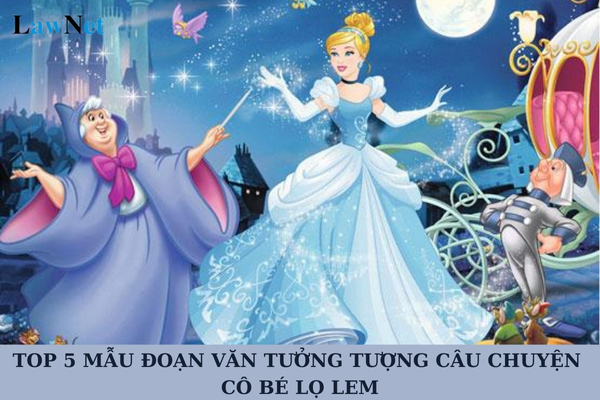Vietnam: What are the Top 5 imaginative paragraphs on the Cinderella story for 4th-grade students? What subjects do 4th-grade students have to study?
What are the Top 5 imaginative paragraphs on the Cinderella story for 4th-grade students in Vietnam?
Writing an imaginative paragraph based on a story you've read or heard is part of the 4th-grade Vietnamese Language curriculum.
Students to refer to the following Top 5 imaginative paragraphs on the Cinderella story for 4th-grade students in Vietnam:
| Sample 1: Fairy tale with a happy ending I think the Cinderella story should not stop when she becomes the prince's wife but should continue to tell about her life afterward. After marrying the prince, Cinderella not only enjoys a luxurious life but also uses her kind heart to help those in need. She asks the king for permission to build a large house for the homeless. Her stepmother and two stepsisters, after days of regretting their bad behavior, come to apologize to Cinderella. She does not hold a grudge but instead invites them to live with her. Her generosity moves her stepmother and stepsisters, and they change to become kind people. I feel that the story is truly complete this way because everyone deserves a chance to make amends. Sample 2: Ending with a magical adventure If I were to rewrite it, I would imagine Cinderella continuing her journey with a thrilling adventure. After marrying the prince, she discovers that her glass slippers have special magic that allows the wearer to go anywhere they wish. One day, she decides to leave the palace to explore the outside world. She meets many struggling people and helps them escape poverty and injustice using the magical shoes. When she returns, she brings back valuable lessons and shares them with the prince so that they can rule the kingdom fairly and happily. I think Cinderella not only deserves to be a queen but also is a brave and talented leader. Sample 3: Modern and realistic ending I think if the Cinderella story happened in modern times, it would have a very different ending. After attending the ball, Cinderella leaves behind one of her glass slippers. But instead of having the prince search for her, she goes to the palace herself to return the slipper. Cinderella tells the prince: "I am very grateful for that special evening, but I want to stand on my own feet before thinking about happiness with you." The prince is surprised but also admires her. Cinderella asks to work in the royal library to have a chance to study. After many years of effort, she becomes a famous scientist. At this point, the prince comes and proposes, and the two build a love based on respect and sharing. Sample 4: Educational ending If possible, I would retell the Cinderella story with a more open and meaningful ending. When the prince finds her thanks to the glass slipper, instead of marrying her immediately, the two of them organize a contest to give other girls a chance to show their talents. Cinderella proves that she deserves to be the prince's wife not just because of her beauty but also through her intelligence and cleverness. After becoming the queen, she helps girls in the kingdom get an education, work, and live independent lives. I think a story like this not only talks about love but also teaches everyone to value themselves and strive for a better life. Sample 5: Ending with a lesson for the stepmother In the story I imagine, Cinderella not only lives happily with the prince but also helps the stepmother and stepsisters change. When the stepmother sees Cinderella become a princess, she regrets what she did. One day, she writes an apology letter and sends it to the palace. Cinderella is not angry and even invites the stepmother and stepsisters to visit the palace. Here, she asks them to help those in need in the kingdom. Over time, the stepmother and sisters realize that kindness is the most precious thing. They work hard, help others, and eventually are loved by the villagers. Seeing their change, Cinderella feels delighted. To me, this is a meaningful lesson about forgiveness and humanity. |
Note: These 05 imaginary paragraphs are for reference only.

What are the Top 5 imaginative paragraphs on the Cinderella story for 4th-grade students in Vietnam? What subjects do 4th-grade students in Vietnam have to study? (Image from the Internet)
What subjects do 4th-grade students in Vietnam have to study?
Under Section IV of the General education program in Literature issued with Circular 32/2018/TT-BGDDT which stipulates the primary education plan:
Compulsory subjects and educational activities: Vietnamese Language; Mathematics; Morality; Foreign Language 1 (in grades 3, 4, 5); Natural and Social Sciences (in grades 1, 2, 3); History and Geography (in grades 4, 5); Science (in grades 4, 5); Informatics and Technology (in grades 3, 4, 5); Physical Education; Arts (Music, Fine Arts); Experiential Activities.
Elective subjects: Minority languages, Foreign Language 1 (in grades 1, 2).
Under the above regulations, 4th-grade students must study the following subjects: Vietnamese Language, Mathematics, Morality, Foreign Language 1, History and Geography, Science, Informatics and Technology, Physical Education, Arts (Music, Fine Arts). These are the compulsory subjects in the 4th-grade education program.
What is the educational orientation of the 4th-grade Vietnamese Language?
Under Section V of the General education program in Literature issued with Circular 32/2018/TT-BGDDT, the educational orientation of the 4th-grade Vietnamese Language is as follows:
- The Vietnamese Language subject helps students use Vietnamese proficiently to communicate effectively in life and learn other subjects and educational activities well; form and develop literary capacity, an expression of aesthetic capacity; and simultaneously cultivate ideas and emotions to help students develop their soul and character.
- The curriculum is designed according to the main strands corresponding to the skills of reading, writing, speaking, and listening. Vietnamese language and literature knowledge is integrated into the teaching process of reading, writing, speaking, and listening. The language materials are selected and arranged suitable for the receptive ability of students at each educational level.

